the history of yeovil's pubs
PUBS HOME PAGE |
PUBS INTRODUCTION |
PUBS BY NAME |
BEERHOUSES |
crown inn (2)
Paradise / Huish
There had been a 17th century inn called the Crown Inn in the Borough although this was later known as the Rose and Crown. Judging by the records below, this version of the Crown, marked as 'A' on the map below, was always a named public house.
In fact the first couple of entries for this Crown Inn locate the premises in Paradise. As seen on the map below, the Crown Inn was flanked by Crown Buildings to the west, Felix Place to the south and Paradise Row, a long terrace of small cottages on the north side of Huish. Paradise Row was demolished in 1936 - the site is now occupied by Tesco's car park.
The only building shown on the map that still stands today is the old Huish school building (marked yellow) which is now part of Tesco's store. This area of Huish, including both sides of the road, was known as Paradise - named after the colloquial name for the burial ground seen on the map next to Huish School. The burial ground, associated with the Tabernacle in Tabernacle Lane, was purchased for £50 in 1907 as an extension to the school playground.
I don't believe that the early Crown Inn was the building photographed below, which I think is clearly later in style (possibly 1880's or 1890's) and, with the appearance of a purpose-built public house, was much more likely to have been owned and rebuilt at a later date by one of Yeovil's breweries as a tied house. Variously listed as an inn and a hotel, the Crown Inn as photographed below, was a two storey red brick building with attic rooms under a slate roof on the corner of Huish and Felix Place, opposite the terrace of housing known as Paradise next to the Yeovil Town Football Ground. The entrance was on Huish and, as seen in the photographs below, the windows were two-light sash windows divided by brick mullions to both floors, the roof dormer and the single storey side extension that wrapped around a separate dwelling. The entrance was flanked by thin round pilasters and surmounted by a stone plaque, Decorative string courses ran around the building at window cill and head heights on both storeys.
As seen in the sketch plans below, a tiny adjoining cottage was acquired when the Crown was owned by J Brutton & Sons. The cottage was demolished and a single-story extension with a flat roof was built in its place. At the same time much of the ground floor layout was re-fashioned.
The Crown Inn closed during the 1970s and for many years was used as the regional office for Bass Brewers.. The building was demolished in 1991 as part of the Tesco redevelopment .
![]()
The first licensee was Felix Curtis, born around 1816 in East Coker, and recorded in Robson's Directory of 1839 and the Somerset Gazette Directory of 1840, However, in the 1841 census Felix was living in Silver Street and gave his occupation as hairdresser. He was still a hairdresser in 1851 by which time he and his wife, Mary, who was eleven years his senior, were living in Middle Street.
John Chaffey appeared briefly as the Crown's licensee. He was born in Yeovil about 1770. In the 1841 census he is listed as a glover living in Paradise Row, described above. In Pigot’s 1842 Directory he was listed as licensee of the Crown, Paradise. The 1842 Tithe Map and 1846 Apportionment show him as the occupier of the inn and Betty Thomas as the owner. In the 1851 census John, listed as an 81-year old glove cutter, was living in the almshouses called Rotten Row in Reckleford. At this time Reckleford was the name of today's Market Street and Rotten Row was just around the corner from the Pall Hotel. The Rotten Row almshouse was not the Woborn almshouse that had stood at the rear of the Pall.
The next licensee, Alfred Slade, was born around 1814 in Stoke-sub-Hamdon, 6 miles west of Yeovil. Alfred had been licensee of a beerhouse in Hendford until 1850 but the 1851 census listed him as an inn keeper at the Crown with his wife, Louisa, and their six young children. The last mention of Alfred at the Crown was in Harrison, Harrod & Co's 1859 Directory and by 1861 Alfred was running a public house in Charlton Mackrell.
Alfred Highmore was born around 1826 in Thorne Coffin, immediately northwest of Yeovil, the son of an agricultural labourer, William Highmore and his wife, Susan. In the 1851 census Alfred was living with his parents and his occupation was listed as a gentleman's servant. By the time of the 1861 census he was licensee of the Crown Inn and living there with his wife, Elizabeth, and their three young children - William, Herbert and Antoinette. In August 1864 Alfred was summoned to the Petty Sessions for having short weights and measures. When defending himself he said, with regard to cider measures that it was impossible to get them exact, but if they looked over his stock they would find that where there was one too small, there were two too large." Fined 40s and costs. In January 1865 Alfred was declared bankrupt and the Highmores had clearly moved on by 1866 as George Randall was being listed as the licensee. In the 1871 census, Alfred is listed with his new wife, Ellen, Herbert, Antoinette and new son, Felix. The family were living in South Stoneham, Hampshire and Alfred was working as a farm bailiff.
George Randall, mentioned above, only made a brief appearance as the Crown's licensee - in Kelly's Directory of 1866. He was born in West Coker, three miles west of Yeovil, around 1814. In 1861 he was living in West Coker with his wife, Harriett, and their baby son, William. George was a master stone mason employing 10 men and three boys. The Crown Inn was obviously a mere diversionary sojourn into the licensed trade as by 1871 he, Harriett and William were living in Queen Street, Yeovil and George was once again a stone mason.
After the flighty George, Louisa Cooper, who was left a young widow, ran the Crown for nearly twenty years during the 1870's and 1880's. She was born around 1820 at Corscombe, Dorset and by 1841 she was married to glover William Cooper and had a baby son called William. The family lived in Paradise Row. Sadly William died in the summer of 1846, aged about 29, leaving Louisa with three young children to look after. In the 1851 census Louisa, still living in Paradise Row, was working as a glove sewer. Indicating how hard life must have been, her 11-year old son, William, was working as a glover and her 9-year old daughter, Louisa, was also working as a glove sewer. Additionally there was 6-year old daughter Elizabeth and Louisa was also acting as nurse to 11-month old Stella Beavis of Milborne Port. By 1871 Louisa was listed as the licensee of the Crown Inn where she lived with daughters Louisa and Elizabeth and boarder Stella Bevis. All three girls were glovers. Louisa was finally listed as the Crown's licensee in Kelly’s 1889 Directory. She died in the spring of 1889.
Walter Bond, the next of the Crown's licensees, was born about 1855 in Yeovil, the son of labourer William Bond and his wife, Sarah, née Hodges. In 1861 the family lived in Wine Street. By 1871 the family had moved to Rustywell, off Hendford, and 16-year old Walter was working as a porter at Hendford Halt railway station. By the time of the 1881 census Walter, now a printer's compositor, had married Yeovil-born glove machinist Lydia and they were living at 62 South Street with their baby daughter, Louisa. Within the next ten years the family had moved yet again and by 1891 William was licensee of the Crown Inn. They stayed here until 1897, according to Walter's listing in Kelly's Directory, but by 1901 Walter was running the Railway Inn in Hendford.
Frank Tuffin was born about 1843 at Farrington, Dorset, the son of miller Jeremiah Tuffin and his wife, Elizabeth. In 1881 Frank was a miller and still living at home with his parents. By 1891 his father had died but Frank, by now aged 47, was still living with his mother and three brothers aged 45, 36 and 34 - all four sons were unmarried (must have been a shortage of girls in Dorset!). Frank was listed briefly as the licensee of the Crown Inn in Whitby's Yeovil Almanack Advertiser of 1900 after which he retired and the 1901 census lists him as a retired former publican aged 49 and living on his own means, with his wife, Flora, son Mervyn aged 4 and 4-month old daughter Florence, all living in Beer Street.
Mary Ann Wilkins was the widow of John Wilkins licensee of the Castle Inn and had been born around 1839 in Yeovil. John, of Galhampton, had been a dairyman in Corton Denham. The 1881 census saw the family living in the Dairy House at Wyke Farm, Sherborne where John was still a dairyman. According to the birthplaces of some of their children, the family had moved around through the years including stops at Corton Denham, Mudford and Chilthorne Domer. In 1889, Kelly's Directory listed John as hotel keeper of the Castle Inn with Mary and five of their children. John was now aged 65 and, having retired from being a dairyman, followed many men's dream of becoming an innkeeper. In 1897 John was still listed as licensee Kelly's Directory but he died in the summer of 1900. Mary left the Castle almost immediately and in 1901 she was licensee of the Crown Inn in Huish with a son and daughter. By this time Mary was aged 62.
In 1907 John
Crapp was listed
as the new
licensee of the
Crown in
Whitby's Yeovil
Almanack
Advertiser. He
was born in St
Stephen's,
Cornwall around
1848. He and his
widow, Mary,
were licensees
of the Crown Inn
from at least
1911 until the
mid-1920's. John Crapp had been
listed as a
Groom & Billiard
Marker in the
1891 census and
as a Retired
Sergeant of the
Army Service
Corps, aged 53,
in 1901. He
died, aged 69,
in 1916 after
which Mary
assumed the
license.
Finally Rosa
Giles was
licensee from
before the
Second World War
until the early
1950's, followed
briefly by SW
Hann.
The Crown Inn was demolished in 1991 as part of the Tesco redevelopment .
map
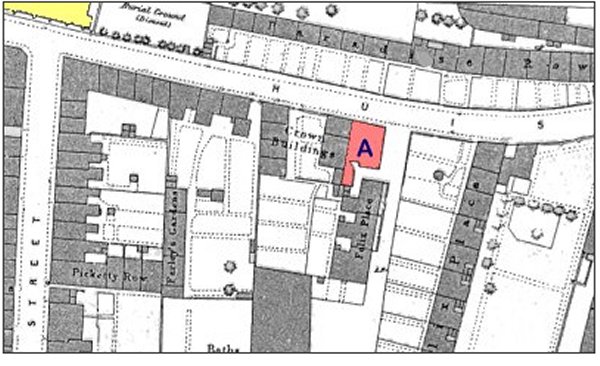
Map based on the 1886 Ordnance Survey with the Crown Inn marked 'A'.
Sketch Plans of the Crown Inn
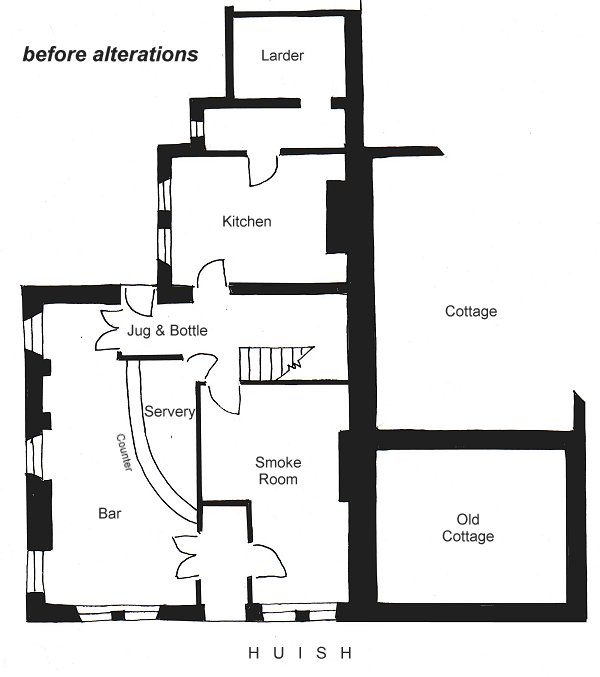
This is a sketch based on plans held at the Heritage Centre, Taunton. The original plans are undated but date to the 1930s when the owners were J Brutton & Sons Ltd.
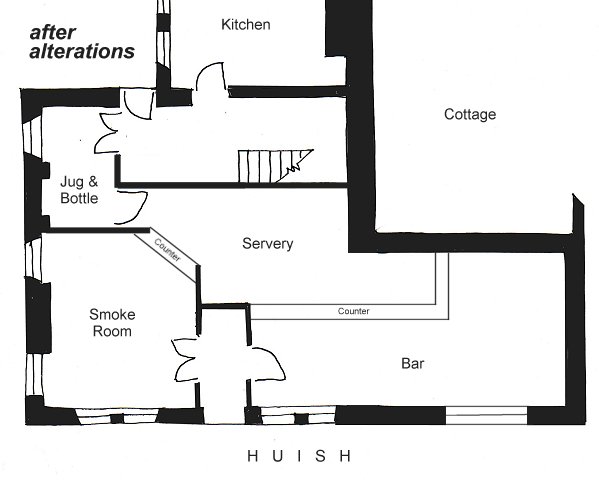
The old cottage fronting Huish was acquired and demolished, to be replaced with a single storey extension with a flat roof. At the same time much of the ground floor was re-fashioned as shown.
gallery
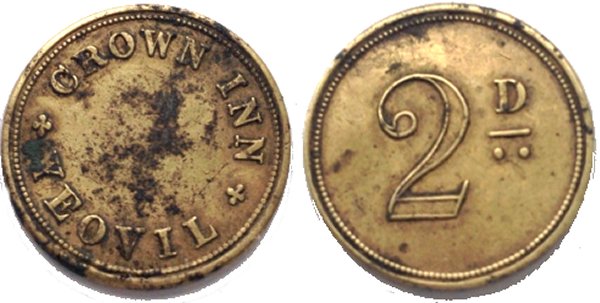
A public house 'check' from the Crown Inn to the value of 2d. Probably dating to the late nineteenth or early twentieth century, the obverse reads "CROWN INN" over "YEOVIL", while the rather plain reverse simply states the value of two old pence. At this time two old pence could buy you a pint of stout.
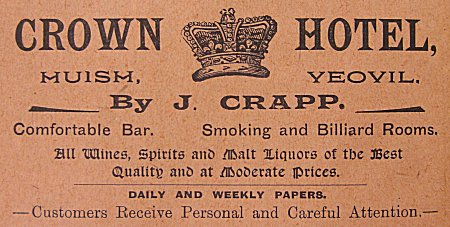
An advertisement for the Crown from the 1913 edition of Whitby's Yeovil Almanack Advertiser.
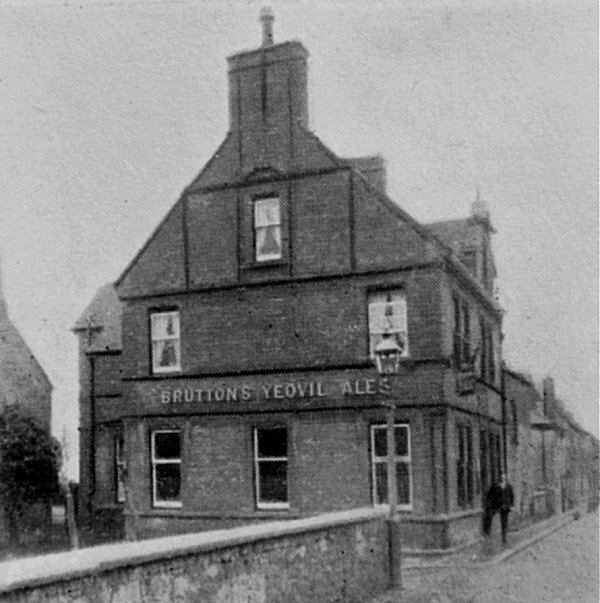
From my
collection
The Crown Inn, photographed in the early 1930s.
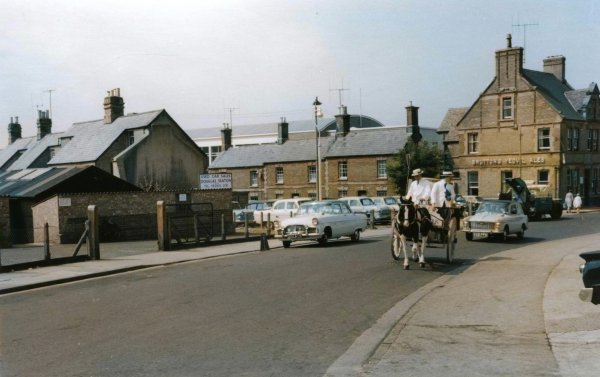
From the Cave
Collection
(colourised),
Courtesy of South Somerset Heritage Collection
A horse-drawn milk delivery cart passes the crown in Huish in the 1960s.
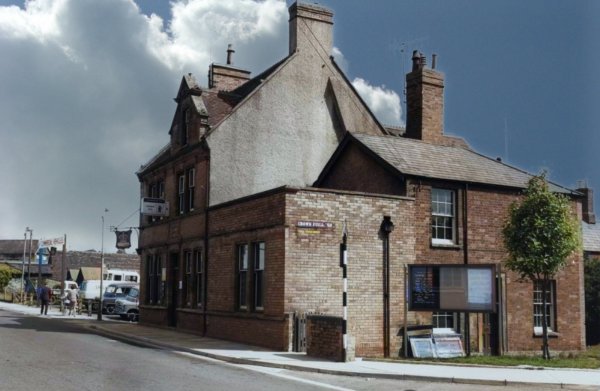
From the
Cave
Collection
(colourised).
Courtesy of South Somerset Heritage Collection
Seen from the west in the 1960s. The swimming pool is off-photo at the right.
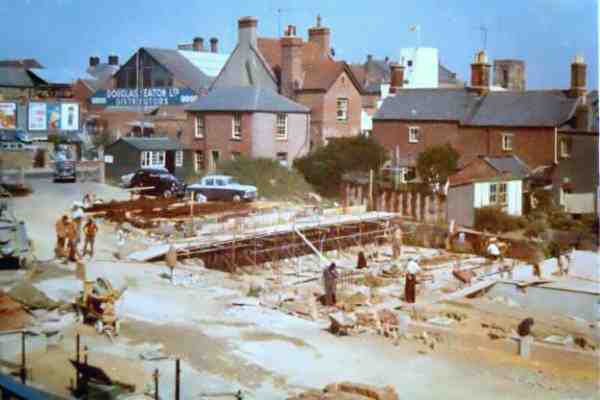
The groundworks of the new swimming pool in Huish, photographed in 1960. At top centre is the rear of the Crown Inn and the cottage built alongside it. At right are the rear elevation of the houses in Felix Place.
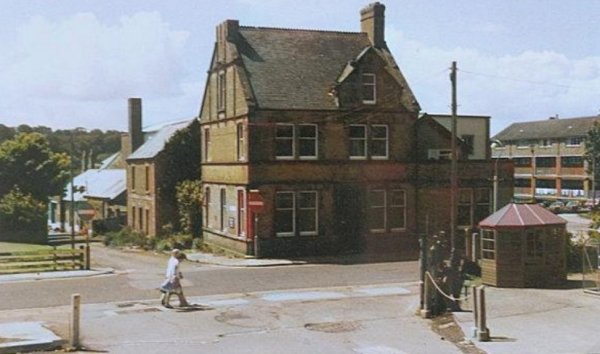
This
photograph
features in my
book "Lost Yeovil"
In this photograph of about 1970 only one house remains in Felix Place's western terrace behind the Crown. Huish runs across the photograph and the narrow street running from the side of the Crown towards the left centre of the photograph is Felix Place. Note the newly-constructed Wellington Flats at right.
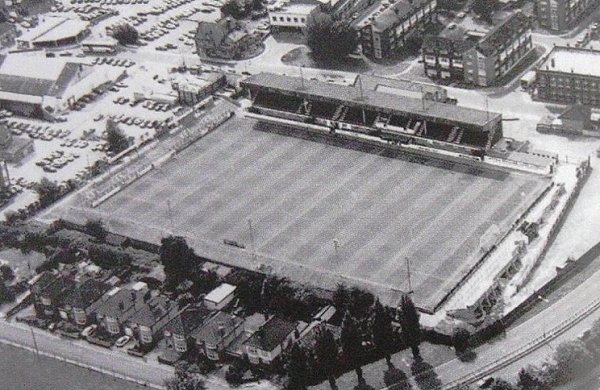
An aerial photograph of about 1980 showing the famous sloping ground of Yeovil Town Football Club in Huish. Huish itself runs across the top of the photograph which shows, from left to right, Felix Place car park, the Crown Inn, the Corporation Swimming Pool and Waterloo flats.
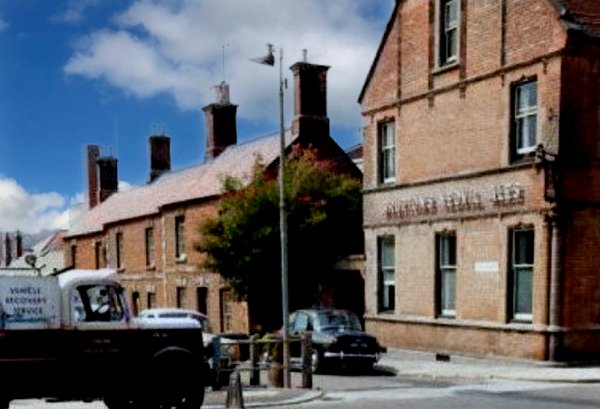
The junction of Felix Place and Huish with the Crown Inn on the corner. At left, behind the lorry, is the old Fairground Field that was turned into a car park.
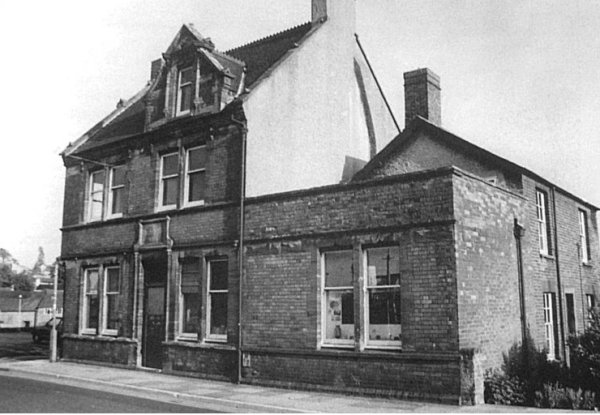
The Crown Inn's Huish elevation, photographed in the early 1980's shortly before its demolition. The single storey extension replaced an earlier cottage that was demolished in the 1930s.
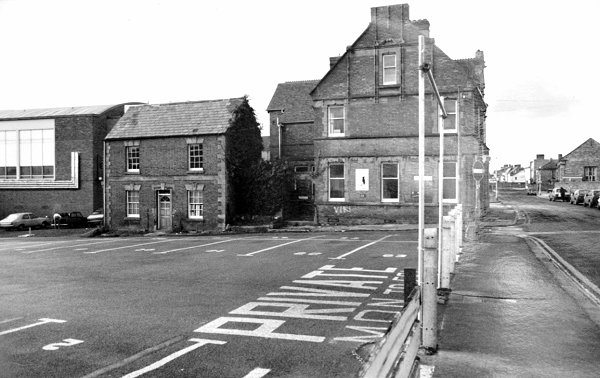
Courtesy of
Chris
Rendell
From left to right; the swimming pool in the background, the last house in Felix Place (the pool manager's house), the Crown, Huish and in the distance the infants school. Photographed in 1985.
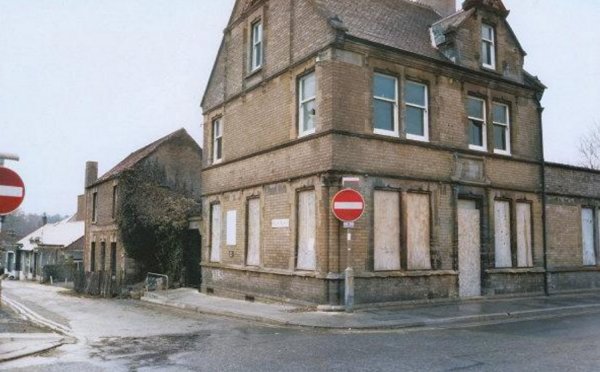
Photograph
(colourised) by
Trevor Hussey,
courtesy of Mrs
Anne Hussey
The Crown, boarded up just prior to demolition. Photographed in 1991.
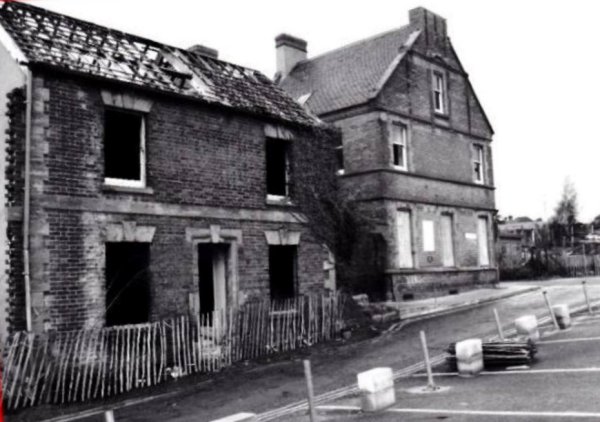
Photograph by
Trevor Hussey,
courtesy of Mrs
Anne Hussey
The Crown, boarded up just prior to demolition and the last house in Felix Place being demolished. Photographed in 1991.
licensees
1835 – Licensee
not named
(Robson's 1835
Directory)
listed as Crown,
Paradise
1839 – Curtis
Felix (Robson’s
1839 Directory)
listed as the
Crown
1840 – Felix
Curtis (Somerset
Gazette 1840
Directory -
Inns) listed as
the Crown,
Paradise
1842 – John
Chaffey (Pigot’s
1842-4
Directory)
listed as the
Crown, Paradise.
1846 – John
Chaffey
occupier, Betty
Thomas owner
(1842 Tithe
Apportionment)
1850 – Alfred
Slade (Hunt & Co
1850 Directory)
listed as Crown,
Huish Lane.
1851 – Alfred
Slade - Inn
Keeper (1851
census)
1852 – Alfred
Slade - Inn
Keeper (Slater’s
1852 Directory)
1859 – Alfred
Slade (Harrison,
Harrod & Co 1859
Directory)
listed as Crown,
Huish
1861 – Louisa
Slade – Beer
Retailer and
Shopkeeper
(Kelly's 1861
Directory)
1861 – Alfred
Highmore – Beer
Retailer
(Kelly's 1861
Directory)
1861 – Alfred
Highmore – Inn
Keeper (1861
census) listed
as the Crown Inn
1864 – Alfred
Highmore – fined
for short
weights and
measures (Petty
Sessions,
August)
1866 – George
Randall (Kelly’s
1866 Directory)
listed as Crown,
Paradise
1871 – Louisa
Cooper (widow
aged 52) –
Publican (1871
census) listed
as Crown Inn.
1872 – Mrs
Louisa Cooper
(Kelly's 1872
Directory -
Hotels & Inns)
1875 – Mrs
Louisa Cooper
(1875 Post
Office
Directory)
listed as Crown,
Huish
1875 – Mrs
Louisa Cooper
(Kelly's 1875
Directory -
Hotels & Inns)
1881 – Louisa
Cooper (widow
aged 62) – Inn
Keeper (1881
census) listed
as Crown Inn
1889 – Louisa
Cooper (by now
aged 70)
(Kelly’s 1889
Directory)
1889 – 'Late' Louisa
Cooper - License
transfer to her
daughter (Petty
Sessions, Sept)
1889 – Louisa
Cooper
(daughter) -
License
transferred
(Petty Sessions,
September)
1890 – Louisa
Cooper - License
transfer (Borough
Petty Sessions,
September)
1890 – Walter
Bond - License
transferred (Borough
Petty Sessions,
September)
1891 – Walter
Bond – Inn
Keeper &
Printer’s
Compositor (1891
census) listed
as Crown Inn
1897 – Walter
Bond (Kelly’s
1897 Directory)
listed as Crown.
1900 – Frank M
Tuffin (Whitby's
1900 Yeovil
Almanack
Advertiser)
listed as Crown,
Huish
1901 – Mary
Wilkins (widow
aged 62) – Hotel
Keeper (1901
census) listed
as Crown Hotel.
1907 – J Crapp
(Whitby's 1907
Yeovil Almanack
Advertiser)
listed as Crown
Hotel, Huish
1911 – Mr Crapp
(1911 census
Summary) listed
as Crown Inn
1914 – John
Crapp (Kelly’s
1914 Directory)
listed as Crown
PH.
1916 – John
Crapp (Whitby's
1916 Yeovil
Almanack
Advertiser)
listed as Crown
Hotel, Huish
1919 – Mrs Mary
Crapp (Kelly’s
1919 Directory)
listed as Crown
1923 – Mrs Mary
Crapp (Kelly’s
1923 Directory)
listed as Crown
PH
1932 – AH
Courtney – see
next entry
1932 – Harry
Ebenezer Giles –
License transfer
from AH Courtney
(Borough Petty
Sessions)
1935 – Mrs Rosa
Bessie Gould
(Kelly’s 1935
Directory)
listed as Crown,
Huish
1936 – RB Giles
(1936 Yeovil
Directory)
listed as Crown
1938 – RE Giles
(1938 Yeovil
Directory)
listed as Crown
1939 – Rosa
Giles (Kelly’s
1939 Directory)
listed as Crown
PH
1947 – RB Giles
(1947 Yeovil
Directory)
listed as Crown
1949 – RB Giles
(Kelly’s 1949
Directory)
listed as Crown
1951 – RB Giles
(1951 Yeovil
Directory)
listed as Crown
1954 – SW Hann
(1954 Yeovil
Directory)
listed as Crown
Hotel
1957 – SW Hann
(1957 Yeovil
Directory)
listed as Crown
Hotel
1965 – Licensee
not named (1965
Yeovil
Directory)
listed as Crown
Hotel
1968 – Licensee
not named
(Kelly’s 1968
Directory)
listed as Crown
Inn